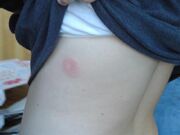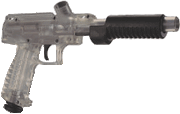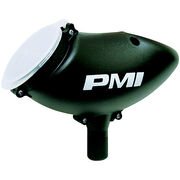
Paintball
What is paintball?[]
Isn't it dangerous?[]
Heck no! Paintball is statistically the safest of all extreme sports, as well as being safer than most (if not all) common sports! As Action Pursuit Games puts it, "the average player will suffer a Paintball injury about once every 500 years." The reason behind this may be because safety rules in Paintball are strictly enforced by referees. :0
Does it hurt?[]

A paintball welt
Yes and no: Usually it stings for a second or two. It's comparable to being snapped by a rubber band. It also depends on how much clothing is on you, because more clothing provides padding for the impact, meaning less pain. To keep the sport fun, all good paintball fields regulate the speed of paintball guns. The speed is always 300 FPS (Feet Per Second) or lower, which has shown to be a safe standard speed.
After getting hit by a paintball, the spot of impact will usually form a ring-shaped welt although some places such as the thigh may form minor bruises.
How Do I Play Paintball?[]
There are many ways to play paintball. They can be broken down into either Speedball, Hyperball, Woodsball, Scenario, or Stock games.
Speedball and Hyperball games[]
Speedball and Hyperball take place on small fields making them fast paced. Speedball is usually played with inflatable structures in many shapes including cubes, pyramids, cylinders, etc. (usually called "bunkers") while Hyperball replaces these inflatable bunkers with large metallic tubes. Tournaments (professional and non-professional) will almost always be played on speedball fields.
Woodsball and Scenario games[]
Woodsball and Scenario are more for recreational players or players who are in pursuit of more realistic simulations. Woodsball is (obviously) played in the woods and is where most paintball players start out. Trees and foliage provide great natural cover, but field owners may add in even more cover with wooden structures, cars, and tires.
A scenario game, on the other hand, is distinguished for its rules and not its setting. These games will have different rules to simulate a different situation, usually with different objectives such as escorting a VIP from point A to point B, or even adding in special roles for certain players (such as medics, demolitions experts, etc.) Scenarios are commonly played in the woods, but can actually be played anywhere you can come up with a good scenario (and where nobody will get hurt by a stray paintball.) Some scenario games include VIP, sniper, terminator, and attack/defend.

The Brass Eagle 'Talon', a common stock marker
Stock games[]
Stock games are slowly regaining popularity. They have the same rules as any other game, and can be played on any type of field. The difference? Everyone uses a cheap 20-dollar plastic pump marker!
Stock games are preferred by many players because it encourages teamwork, and it saves money. Pump markers (see 'Markers' section) greatly restrict the player's firing speed so they are forced to conserve ammunition. New players also tend to waste paint when using a mechanical or electronic marker, so stock games are usually the best place for new players to start their paintball experience so they learn the value of using strategy over firepower and technology.
Some high-end markers are also made and sold with stock paintball in mind.
What Do I Need To Play?[]
Every paintball player must be equipped with a marker, a mask, paint and a large area to play in. Optional equipment includes squeegies, pod packs/harnesses, and pods (filled with extra paintballs).
Money[]
First and foremost, you will need money if you want to do paintballing as a hobby. Paintball fanatics are known to have very little money for anything that doesn't involve shooting paint at things, living or nonliving. Good players who get enough attention can aquire financial support from a sponsor for them to play in tournaments.
Markers[]
This is obviously the most important piece of equipment for playing. Markers come in many shapes and sizes, and some operate in different ways than others as well as using different parts. The price of a marker can be as low as 20 and as high as several thousand dollars. A first-time player who is unsure if they want to play or not should not buy a marker, and should instead rent a marker for their first game to see if they enjoy it or not.
There are generally five types of markers: Pump, Mechanical, Electronic, Pistol, and Other.
Pump[]
Pumps are obviously identified as having a shotgun-like pump under the barrel. Using it takes a while to get used to, but the concept is simple: after a shot is fired, you pump it once so you can fire again.
It takes a while to fire another round, so most experienced players will recommend that new players start with using pump markers in regular games or by playing in stock games to develop good habits of paint usage. New players are known to develop the bad habit of wasting paint.
A variety of pumps are available to players but they are much harder to find than regular markers. Pumps aren't just for starting players though, there are also high-end markers that are pump-action. The prices of pumps can vary from $20 to hundreds of dollars.Alot of times you can rent a gun from a the place that you play at.
Mechanical[]
Mechanical markers are the traditional paintball gun. No pump and no batteries make them the popular choice for the general paintballing crowd. They fire as fast as most players need their markers to fire and come pretty cheap compared to many electronic markers. That's not to say that expensive markers are all electronic, though. Plenty of high-end markers are mechanical.
Electronic[]
Most professional players in paintball will be found using electronic markers, but even markers as cheap as 80 dollars can be found with electronic hardware. Electronic markers have much less trigger-pulling resistance than mechanical markers. They also don't require the player to pull the trigger as far, and can thus be fired exponentially faster than the mechanical markers as well.
Often, electronic markers have the option of using different firing modes. Usually these firing modes can be: safety, semi-automatic, reactive (one shot on pull, one shot on release), ramping (shoots in full-auto if the trigger is pulled often enough), 3-shot burst, 5-shot burst, and full-automatic. The experienced players usually use semi-automatic because many fields and tournaments don't allow full-auto, and because they can fire much faster than automatic using the semi-automatic setting.
Players almost always combine their electronic markers with motorized hoppers because of the fast firing speed. Normal gravity-fed hoppers can't feed paintballs into the gun fast enough
Pistol[]
A pistol marker is loosely-defined as a very compact marker. They will usually take small 12-gram CO2 cartridges and use mechanical or pump action.
A pistol is almost always intended to be a backup marker in case the first one jams or is out of air, etc. Some people, on the other hand, have decided that a pistol (or two) is all they need to win.
Keep in mind that a pistol has a very short range and has a small magazine. Holsters and extra magazines are almost always available from the manufacturer.
Other[]
Some markers aren't really markers at all, they just happen to launch paint. Specifically, wrist rockets and blowguns.
Some people use wrist rockets as cheap alternatives to spending any money at all on air and barely spend anything on paint because of the slow firing rate. Its simplicity of operation also guarantees no mechanical failure.
Blowguns are a rare sight, and they usually use small .38 paintballs as opposed to the normal .68 paintball. The .38 paintballs are somewhat easy to find online but finding them in stores is difficult, although blowguns save money on air and are very simple to use.
Masks[]
In paintball a mask is REQUIRED in order to be in the playing field because it provides protection for your face, ears, and eyes. As we all know, paintballs travel at fast speeds, and getting hit in the face without protection can result in painful and unnecessary injuries such as lost teeth, cataracts, and blindness. Every paintball field has a rule about keeping your mask on when in a paintball field, so you had best follow it. It is guaranteed that anybody who violates this rule will have a referee yelling in their face and banning them from the game for a few rounds, if not the rest of the day.
Some masks will add additional protection for your neck, or even the top and back of your head. A common problem with some masks is fog appearing on the lens. This is avoided by replacing them with a thermal lens, or just buying a mask with a thermal lens in the first place. These thermal lenses are made to prevent fogging and are highly recommended by all paintball players.
Tanks[]
A tank is a canister filled with either carbon dioxide (CO2), compressed air, or nitrogen (N2). These are all compressed gases that are used to project paintballs out of your marker. Certain markers such as the Autococker can only fire compressed air and nitrogen because carbon dioxide has physical properties where it tends to expand even after it has exited the tank.
Tanks come in many capacities, shapes and materials. They will have screw threads on one end and are meant to be screwed into the bottom, backside, or sometimes front, of the marker.
Tanks are made to be safe and durable during a game, but high pressures inside the tank still mean you MUST treat it with care. Heed the warnings written on the tank. Leaving it in hot temperatures, dropping it on the pavement, hitting it with a tack hammer, etc. might ruin your day.
Hydro Testing[]
US Department of Transportation (DOT) regulations govern all compressed gas cylinders. Their manufacture is done under specific guidelines which include the required testing interval and method. If a manufacturer wishes to use a previously unapproved tank design, they must solicit a Special Permit. You will see this designation on the side of any approved tank -- 'DOT-SP'. An example is the lightweight Luxfer carbon fiber tank that many players have used over the past several years. DOT-SP 10915 (http://phmsa.dot.gov/staticfiles/PHMSA/SPA_App/OfferDocuments/SP10915_2009100578.pdf) is the permit under which those carbon fiber tanks are created and maintained. This permit sets out the testing period as follows in section 7b:
- "Cylinders retested prior to May 11, 2001 must be retested within 36 months of the retest date marked on the cylinder. Cylinders retested on or after May 11, 2001 must be reinspected and hydrostatically retested at least once every five years."
Many players rejoiced when the news came out that the hydro test period was extended from 3 to 5 years. It meant lower maintenance costs and better resale values for used tanks.
If you have an expensive tank you don't want to trash, you can take it to a scuba (dive) shop, paintball store or field that does hydrotesting, and they can send it out for testing to be recertified for another five years of use.
If the tank passes the test then they will slap a new date on your tank and instead of buying a new tank you can go spend your money on something better, like a new barrel or a nice jersey!
If you have a tank that is past its date and you don't want to bother hydrotesting it, don't just put it in your trash! Your local paintball store will know how to dispose of it in a safe and proper way.

A simple gravity-fed hopper
Hoppers[]
A hopper is a pod that usually fits on top of your marker, and it holds and dispenses paintballs to your marker as you fire them. Hoppers usually hold around 200 rounds (except for stock markers which hold between 10 and 20).
Hoppers usually feed paintballs to your marker just with gravity, but sometimes that's not fast enough to keep up with the rate you're shooting at. To keep up, there are motorized battery-powered hoppers that will force paintballs into your marker at a faster rate than normal gravity-fed hoppers can. Beware though, being able to fire faster tends to develop a bad habit of wasting paint.
Your A-game[]
Regardless of what type of game is being played, paintball presents its players with both physical and mental challenges. Games typically require speed and stamina from its players, as well as reflexes, strategy/tactics, and communication with your teammates.
Teamwork is the most important key to winning a paintball game. Never start a game without a strategy for you and your team.
Communication is the second-most important. If you observe a real team in action, they will be yelling the position of the enemy to the rest of their teammates, and someone may be issuing orders or telling their team what they're about to do. Codewords (made up by the team) are used so the enemy doesn't use a team's own yelling against themselves.
What to Wear[]
First-timers and uncommon players should wear old jeans, a old pair of shoes/boots with good traction in dirt, and a sweat shirt over a tshirt. Expect to get dirty. If it's your first time DO NOT wear a T shirt and shorts. I've seen a girl play in a tank top, bad idea. Keep in mind the more clothes you're wearing the more padding you're gonna have. If you have enough clothing on you're also more likely to get a paintball to bounce off of you instead of breaking.
More experienced or professional players tend to invest in jerseys, pants, and shoes made exclusively for paintball. Jerseys are usually made from quick-absorbing material and usually have padding in the shoulder/elbow area for going prone, and non-slipping areas in front of the shoulder that provide a good surface to brace their tank on for a steadier shot. Paintballing pants are also full of padding, and the shoes are made to provide traction. Buying paintball clothes isn't needed to play and isn't needed to have fun, and they cost quite a bit more than normal clothes so only buy it if you're becoming a serious player.
Testicle cups are important for the men for obvious reasons, but are often ignored. Although a shot to the nuts is a rare occurrance, an experienced paintballer will usually have either witnessed or experienced such a tragedy during a game.
Kneepads and elbow-pads are also made and sold for paintball so players can take hard dives without getting hurt.
Physical Conditions[]
Even if you are physically challenged or injured, the game of paintball may still have a place for you. Slower teammates are perfect for staying behind to provide covering fire and maintain defensive positions. Some people have been known to play paintball with the use of a wheelchair, and there are even entire paintball teams made up of people with disabilities.
Paintballing in the Seattle area[]
Washington's abundance of forest make woodsball and scenario games a popular choice, but speedball/hyperball fields can also be found easily. There are really no fields in Seattle, because rent tends to be high around the urban areas, and because paintball fields (both indoor and outdoor) tend to take up large areas, so players have to go for 20-60 minute drives outside of Seattle to find a field.
Indoor Fields in the Seattle area[]
- Doodlebug Sportz in Everett
Outdoor Fields in the Seattle area[]
- DoodleBug Sportz Paintball in Snohomish
- Eastside Paintball in Duvall
- KC Crusaders Paintball in South Prairie
- Operation Paintball in Graham
Local Stores[]
DoodleBug Sportz paintball in Everett.
Features a full proshop
Wikipedia's Article on Paintball
Warpig One of the best Paintball websites
PB Review Washington Paintball field Reviews
Mcarterbrown.com The best of the old school paintball websites
PBnation One of the largest paintball websites
PaintballReservations.com Seattle Area Paintball Field Information and Reservations.